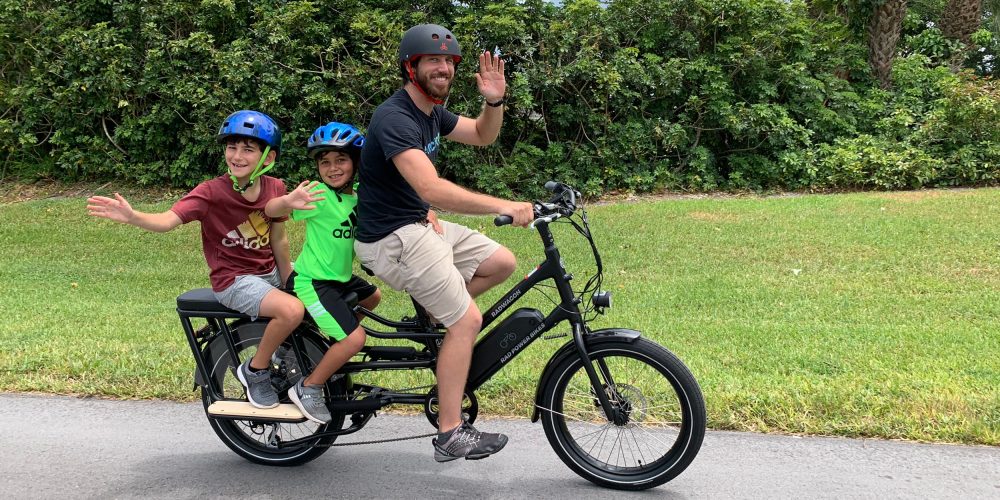
The idea that electric bicycles are “cheating” has long since been written off. With the massive adoption of electric bicycles under way and multiple studies confirming that electric bicycles provide nearly as much exercise as pedal bicycles, a new real-world test is now helping us get a better idea of exactly how much exercise different levels of electric pedal assist can provide.
The real-world test was performed by Rad Power Bikes, the leading North American manufacturer of electric bicycles. It sought to determine how many calories were burned when riding e-bikes using pedal assist.
As Rad’s Justin Duckham explained:
A lot of our customers reach out to us and ask if they can use their electric bikes to workout. We wanted to put that to the test, so we got five of our friends and asked them to go on a 30-minute ride around our office. And to make things interesting and to get a better understanding of what kind of workout you can expect, we assigned each of them a different level of pedal assist, which basically determines how much power the motor gives you on your ride.
Fitness trackers were used to calculate each rider’s calorie burn during the test.
Instead of performing a scientific study with nearly identical riders on identical bikes, they purposefully used on different bikes to give a sense of the level of real-world exercise across a wide range of rider types.
For example, the five riders in the test and their bikes were:
- Rider 1 on a : 6’3″ and 250 lb
- Rider 2 on a : 5’3″ and 94 lb
- Rider 3 on a : 6’4″ 205 lb
- Rider 4 on a : 5’1″ 108 lb
- Rider 5 on a : 5’9″ 185 lb
Thus, the results are more of an indication of exercise level across a spectrum of riders than a rigorous scientific analysis of exact calorie burn.
But through the use of fitness trackers worn by each rider on an identical 30-minute route consisting of both flat and hilly sections (seen in the video below), we’re able to glean some interesting info.
Below you can see the results of the calorie burn for each rider.
One thing to keep in mind is that larger individuals tend to burn more calories than smaller ones, as do individuals with lower fitness levels that are just beginning an exercise routine.
That correlates with the interesting results that show a spread of calories burned across the pedal assist range.

While I certainly expected the results to follow the pedal assist level with fewer calories burned when more assist was used, the variation in rider size definitely plays a large role.
The heaviest rider on a RadRover fat tire e-bike using Level 1 pedal assist (bless his heart… and quads) burned 325 calories on the ride, or a very respectable 650 cal/hr rate. That definitely makes sense.
But interestingly the Level 5 pedal assist rider of medium height and build on a RadWagon electric cargo bike still worked out at a respectable 358 cal/hr. It’s not as high as the Level 1 pedal assist rider, but it sure beats the 75 cal/hr I’m burning while writing this article.
Granted, that electric cargo bike isn’t light, but Level 5 pedal assist also means the bike is putting out a lot of power. Yet by pedaling along even with the e-bike in its highest power mode, the rider still got in a fair workout.
We can also see how the smaller female riders also burned the fewest calories, which makes sense based on their body masses. It further demonstrates how unique the e-bike exercise experience is for each rider, and how tests like these help illustrate that point.

The nice thing about this test is that it allows us to find the rider closest to ourselves and get an idea of our own potential exercise level on such e-bikes. For example, Rider 5 on the cargo e-bike matches most closely with my build, and so I know that I can still get in a decent workout even with max assist on that e-bike.
All of this aligns with what several more scientifically rigorous studies have determined: that electric bicycles can provide nearly as much exercise as pedal bikes. In some cases, e-bikes actually provide more net exercise as they cause riders to ride further and for longer durations.
Tests like these also go to show that you don’t necessarily need the fanciest fitness e-bikes to get in a good workout. Sure, I’d love a Specialized Turbo Vado SL, but it’s not quite in my budget.
Personally, I’ve been experimenting more with e-bike fitness in addition to using e-bikes purely for sustainable transportation. I often switch between my Priority Current for pure road riding and my RadMission for gravel-style riding. when I got mine and , though both have increased in price slightly since then. Both bikes also show that you don’t need an e-bike priced as high as a car to get in a workout.
The Priority Current is pedal assist only and thus keeps me honest. The RadMission has a throttle as well as pedal assist. I like the throttle for getting me out of a jam and as a safety feature, but I try to use pedal assist as much as I can when I’m not in a hurry. In fact, lately I’ve been pushing myself with something I’m calling “no throttle Thursdays,” where I don’t even touch my throttle and focus purely on enjoying a nice pedal-assisted ride.
However you like to get your e-bike fitness in, you can rest assured that despite the naysayers fading away behind you, you’re definitely getting in some well-earned exercise.
Just one of the many benefits of e-bikes!
Subscribe to Electrek on YouTube for exclusive videos and subscribe to the podcast.
Author: Micah Toll
Source: Electrek



